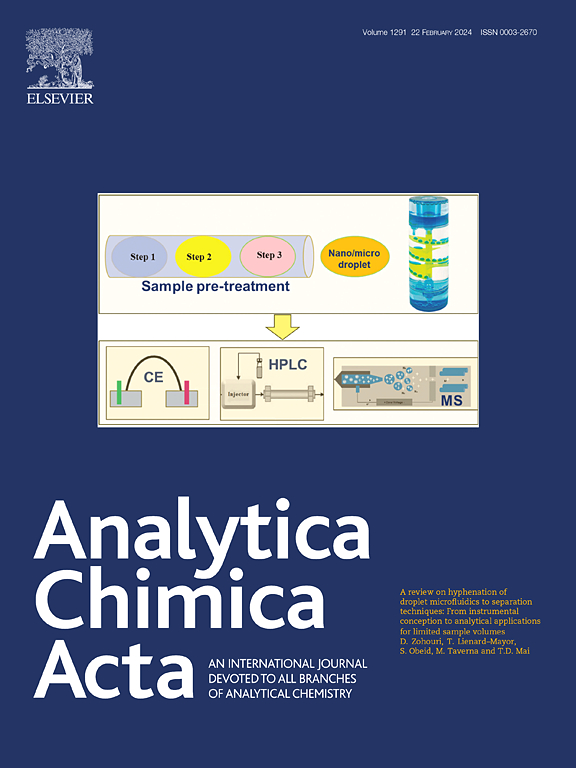On-site monitoring of atrazine in edible oils: Integrating reverse phase transfer extraction with lateral flow immunoassay for rapid screening
IF 6
2区 化学
Q1 CHEMISTRY, ANALYTICAL
引用次数: 0
Abstract
Background
Sample pretreatment is pivotal yet frequently overlooked in rapid biosensor development. Conventional extraction of lipophilic pesticides (e.g., atrazine) from edible oils relies on organic solvents and multistep procedures, which drastically limit detection speed. To address this limitation, this study developed a hazardous-solvent-free, single-step extraction method for atrazine in edible oils, coupled with lateral flow immunoassay strips for rapid detection.
Results
The study found that using a 10 mmol/L Tween-80 solution with an oil-to-water phase ratio of 1:2 (V/V) and an extraction time of 2 min yielded the highest extraction efficiency. The total pretreatment and detection time of this method was less than 15 min, with a limit of detection (LOD) of 0.096 μg/kg and a linear range of 0.32–72.9 μg/kg for atrazine in edible oils. The method demonstrated spiked recoveries of 83.61 %–120.00 %, and cross-reactivity with potential interfering substances (e.g., typical contaminants and additives in oils) was below 1.41 %. Further investigation into the extraction mechanism revealed that atrazine in the oil phase was extracted by aqueous Tween-80 micelles, and it was hypothesized that micelles with a dynamic light scattering (DLS) measured hydrodynamic diameter of approximately 35 nm likely played a predominant role.
Significance
In conclusion, this study established a green, simple, and rapid hazardous-solvent-free method for atrazine detection in edible oils. Furthermore, the mechanism of Tween-80-mediated atrazine extraction was investigated, proposing a novel theory of Reverse phase transfer extraction, which provides new insights for developing eco-friendly liquid-liquid extraction strategies for lipophilic contaminants.

食用油中阿特拉津的现场监测:将反相转移萃取与横向流动免疫分析法相结合进行快速筛选
样品预处理在快速生物传感器开发中是至关重要的,但经常被忽视。从食用油中提取亲脂性农药(如阿特拉津)的传统方法依赖于有机溶剂和多步骤程序,这大大限制了检测速度。为了解决这一局限性,本研究开发了一种无危险溶剂、单步提取食用油中阿特拉津的方法,并结合横向流动免疫测定条进行快速检测。结果采用10 mmol/L的Tween-80溶液,油水比为1:2 (V/V),提取时间为2 min,提取效率最高。该方法对食用油中阿特拉津的检出限为0.32 ~ 72.9 μg/kg,总预处理时间和检测时间均小于15 min,检出限为0.096 μg/kg。该方法加标回收率为83.61% ~ 120.00%,与潜在干扰物质(如油品中的典型污染物和添加剂)的交叉反应性低于1.41%。进一步的萃取机制研究表明,油相中的阿特拉津是通过吐温-80水相胶束进行萃取的,并且假设动态光散射(DLS)测量的水动力直径约为35 nm的胶束可能起主导作用。结论:本研究建立了一种绿色、简单、快速、无危险溶剂的食用油中阿特拉津检测方法。此外,研究了吐温-80介导的阿特拉津萃取机理,提出了一种新的反相转移萃取理论,为开发亲脂性污染物的环保型液-液萃取策略提供了新的见解。
本文章由计算机程序翻译,如有差异,请以英文原文为准。
求助全文
约1分钟内获得全文
求助全文
来源期刊

Analytica Chimica Acta
化学-分析化学
CiteScore
10.40
自引率
6.50%
发文量
1081
审稿时长
38 days
期刊介绍:
Analytica Chimica Acta has an open access mirror journal Analytica Chimica Acta: X, sharing the same aims and scope, editorial team, submission system and rigorous peer review.
Analytica Chimica Acta provides a forum for the rapid publication of original research, and critical, comprehensive reviews dealing with all aspects of fundamental and applied modern analytical chemistry. The journal welcomes the submission of research papers which report studies concerning the development of new and significant analytical methodologies. In determining the suitability of submitted articles for publication, particular scrutiny will be placed on the degree of novelty and impact of the research and the extent to which it adds to the existing body of knowledge in analytical chemistry.
 求助内容:
求助内容: 应助结果提醒方式:
应助结果提醒方式:


